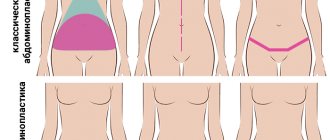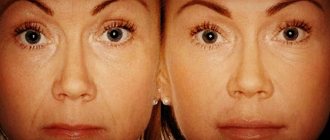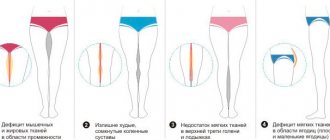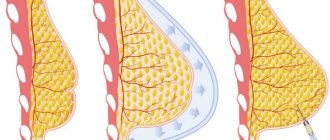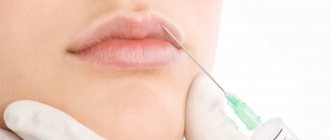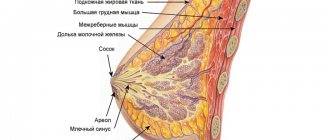Recommendations for lipofillingAdvantagesFeatures of lipofillingResults of lipofillingRehabilitation
Complications after the procedure Feedback from our clients Questions and answers Who to sign up for Prices
For breast modeling, not only artificial implants can be used, but also the patient’s own fat tissue. Breast lipofilling is a plastic correction technique that is considered one of the safest. Fat is used to eliminate almost all types of aesthetic defects: to enlarge the breasts, change their shape or eliminate asymmetry.
All photos of breast lipofilling
Recommendations for breast lipofilling
- The patient’s inability or unwillingness to install breast implants in order to change the shape and volume of the mammary glands.
- The need for additional correction after breast replacement in thin women to prevent displacement of the implants and build-up of the subcutaneous fat layer above them (as a preventive measure for contouring).
- A slight change in volume with modeling the shape, oval, eliminating slight asymmetry of the mammary glands.
Breast lipofilling can also be performed in combination with liposuction to create more proportional, seductive body contours.
Prices
| Operation | Cost of the operation, rub. |
| Lipofilling – 1 zone | 30 000 |
| Lipofilling - breast | 150 000 |
Stages of the operation
To ensure the safety of our patients, consultation and medical examination are carried out before the intervention. Lipofilling of the mammary glands is carried out in several stages:
- collection of adipose tissue by liposuction with a special cannula using the liposuction method;
- separation of fat cells from the solution (lipoaspirate processing);
- enrichment of adipose tissue with one’s own stem cells, previously obtained from lipoaspirate, for better engraftment of fat cells;
- injection of adipose tissue into the breast with a special cannula that does not injure blood vessels and nerves.
The operation time is on average 1-1.5 hours. There are no cuts or seams, punctures are sealed with special sterile adhesives. You can take a shower the next day after surgery.
Breast lipofilling gives the effect of filling and enlargement. The procedure can be repeated after a few months to achieve the desired result - breast enlargement by 2 or more sizes. The survival rate of fat cells in our clinic is up to 80% of the total transplant volume. Lipofilling is an absolutely environmentally friendly method that eliminates any allergic reactions, since the material is the patient’s own adipose tissue.
The main advantage of the method is the successful solution of several problems at the same time: effective correction of the figure through liposuction from unwanted places and rejuvenation, breast enlargement through the use of one’s own biological material.
Rehabilitation is short. Swelling and bruising disappear within a month. Wearing compression garments – 1 month. For the purpose of rapid rehabilitation and recovery, patients undergo procedures - plazonotherapy, microcurrent therapy on the body from the first day after surgery. After a month, massages and RF can be performed. Procedures are prescribed individually, taking into account the patient’s capabilities. In the summer, compression garments for small volumes of liposuction are replaced by taping.
Benefits of Breast Augmentation with Fat
- There is no risk of rejection, since instead of artificial implants, the patient’s own tissues are introduced, which cannot be identified by the immune system as antigens.
- With lipofilling, patients receive not only beautiful breasts, but also correction of body contours in problem areas - the biomaterial is taken from the place of the greatest accumulation of fatty tissue.
- Subcutaneous injection of fat additionally provides intensive nutrition to tissues, stimulating their renewal.
- Our surgeons’ experience and proprietary innovative techniques allow us to enlarge the breasts by 1 size.
- A natural result is achieved thanks to the lipofilling technique and the absence of traces of surgical intervention - scars.
- The versatility of the procedure is due to its aesthetic effect - with the help of fat, not only breast augmentation is carried out, but also breast modeling, the upper edges of implants protruding under the skin are hidden when there is a lack of soft tissue.
Need a consultation?
Methodology of the procedure
Breast augmentation and shape enhancement by injecting your own fat is a minimally invasive procedure. The exact result is ensured by several stages:
- Pumping out adipose tissue. The material that will then be introduced into the mammary glands must be its own. It is taken from the outer areas of the buttocks, abdomen or thighs. The water-jet liposuction method used in this case allows for maximum preservation of the volume of adipose tissue, cell integrity and sterility. Incisions of less than 5 mm are made on the body, into which cannulas with a rounded tip are inserted, rather than sharp needles, as many people think. This allows you to avoid damage to blood vessels and nerve endings. A special solution supplied by the device makes fat deposits less dense. They are pulled out like a syringe, ensuring the preservation of intact, sterile cells. When the material is taken, the puncture sites are sealed with an antiseptic plaster.
- Bringing adipose tissue to readiness for transplantation. The material obtained as a result of liposuction must be processed. At the moment, it contains unnecessary impurities of natural and synthetic origin. To get rid of them, the fat is placed in a medical centrifuge for purification. There, tissues intended for insertion into the breast are treated with a solution that facilitates their engraftment.
- Filling the mammary glands with biomaterial. The prepared fat is injected. To achieve the result, the distribution of the donor material is evenly arranged in the likeness of a honeycomb. Adipose tissue is placed in the muscle space, which gives the effect of enlargement. When the required amount has been entered, the operation is completed. The puncture points are protected with an antiseptic plaster.
Actually, for most women, the question of how to enlarge breasts with fat boils down to the fact that the patient will fall asleep for a short time and come to her senses with improved forms.
Breast lipofilling
Features of breast lipofilling
Lipomodeling can be either an independent operation or an integral component of plastic correction of the breast, face or other parts of the body.
Lipofilling is performed under local or general anesthesia. The choice of anesthetic drug depends on the severity of aesthetic breast defects and, accordingly, the chosen tactics of surgical correction. The duration of the operation varies from 30 to 60 minutes. The maximum period of inpatient treatment after breast augmentation with fat does not exceed 1 day.
The only limitation during the rehabilitation period, which lasts up to 3 weeks, is the exclusion of physical activity.
Price for breast lipofilling
The price for breast lipofilling depends on many factors: the location and level of the clinic, the qualifications of the doctor, the quality of anesthesia and the complexity of the operation, which is determined individually in each case. The average cost is:
- Ukraine - 35,000 hryvnia;
- Russia - 150,000 rubles;
- Czech Republic - 30,000-70,000 Czech crowns;
- Poland - from 10,000 zlotys.
Breast lipofilling procedure
After a set of diagnostic measures, in the absence of contraindications, surgery is performed.
- At the first stage, donor fat tissue is collected using lipograft syringes (usually from the patient’s abdomen or thighs).
- Then the biomaterial is purified from foreign impurities under conditions of strict sterility. To speed up the process of fraction separation, laboratory centrifuges are used.
- Breast lipofilling is performed by injection. Fatty tissue is injected under the muscles (to prevent its migration) and a rigotomy is performed to ensure correct distribution of the graft.
Lipofilling
In modern plastic surgery, there is a serious alternative to implant breast augmentation - lipofilling. Breast lipofilling is a procedure that combines elements of liposuction with injection methods. Simply put, fatty tissue is taken from the patient herself from the abdomen or thighs and injected into the intermuscular space of the mammary gland, increasing its volume and giving it a more perfect shape.
The operation allows you to increase your bust size by 0.5-2 sizes. It lasts no more than two hours and has virtually no contraindications. The appearance of the breast after lipofilling is completely indistinguishable from the natural one, either visually or tactilely. Breast augmentation using lipofilling does not entail any significant complications.
The lipofilling procedure is perfect for women who decide to restore the harmonious shape of their bust after pregnancy and childbirth, sudden weight loss; this technique is also suitable in cases of asymmetry of the mammary glands, as well as in cases of breast correction after cancer.
The idea of moving a patient's own fat tissue from one area to another is not new. Similar techniques were used back in the 19th century, but gained particular popularity in the 80s of the twentieth century. However, both doctors and patients soon faced a significant problem. Despite the simplicity of the operation and the absence of serious complications, the displaced fat cells dissolved rather asymmetrically over time or did not take root.
However, today this problem has been solved. Firstly, stem cells began to be added to adipose tissue, thereby improving the process of hematopoiesis in the implanted tissues and increasing the percentage of cell survival to 80%. In addition, the scientific institute of the American Society of Plastic Surgeons, namely Dr. Khouri, has developed a special device - the Brava® vacuum bra to expand the internal intermuscular space of the chest.
The device is worn in preventive mode for three weeks before the lipofilling procedure. With the help of negative pressure (vacuum), there is more space for injected fat cells in the mammary gland. Without this innovation, up to 80 ml of adipose tissue could be transplanted in one injection. Today, with the help of pre-expansion, it is possible to increase the volume of injected fat cells to 240 milliliters.
Thus, breast augmentation using lipofilling has been improved and has become the most effective and safe way to correct the volume and shape of the mammary glands. The use of the patient’s own biological material allows one to avoid rejection, allergies and other undesirable consequences. Thanks to this, the procedure is as gentle and safe as possible.
Rehabilitation
Swelling and hematomas in the correction area disappear within a few days. Two weeks after breast lipofilling, it is necessary to minimize thermal, mechanical, and chemical effects on the mammary glands, and reduce physical activity. To enhance tissue healing, it is important to use external medications prescribed by your doctor.
The final result of aesthetic manipulation will appear six months after complete tissue regeneration.
Contraindications
- Chronic, inflammatory, infectious processes in the acute stage.
- Autoimmune pathologies.
- Diseases of the endocrine system.
- Disturbances of hemostasis and blood circulation.
- Oncopathology.
- Pregnancy, lactation.
Rehabilitation period
The total rehabilitation period will take 2 - 3 weeks. The procedure is done with minimal tissue trauma, so recovery after lipofilling is quite comfortable. The next day after it, you are allowed to peel off the antiseptic patch from the wounds. At the same time, the patient is sent home.
For the first 7 days, pain may be felt in the operated area. The pills prescribed by your doctor will help you get rid of it. But in most cases, women do without pain medication.
Swelling and bruising on the skin also occur, but they are minor and disappear within the first week. This rapid recovery is explained by the fact that fat cells have a stimulating effect on the processes occurring in the connective tissue. That is, they promote the production of collagen, the delivery of nutritional components and not only regenerate damaged areas, but also rejuvenate the body.
Compression garments after breast lipofilling
In order for all processes to proceed without disturbances and the result to be as intended, certain conditions must be met:
- limit physical activity, especially affecting the upper body;
- wear compression garments for the entire rehabilitation period (month);
- avoid putting pressure on the mammary glands, therefore, sleep on your back and do not fly by plane for at least the first 2 weeks;
- give up hot, spicy and salty foods, so as not to stimulate the resorption of adipose tissue and not to delay swelling in the mammary glands;
- do not drink alcohol or smoke to avoid inhibiting recovery processes and causing complications;
- do not expose your breasts to overheating, that is, postpone visiting the bathhouse, solarium, taking a hot bath and staying on the beach until later;
- do not overuse cool compresses on the chest, which, although they quickly eliminate swelling, contribute to the resorption of fatty tissue.
Possible complications
Like any other operation, breast lipofilling is accompanied by temporary adverse reactions, including:
- swelling of soft tissues;
- hematomas;
- decreased sensitivity;
- slight soreness.
It is impossible to avoid these complications, but they do not cause serious harm to health and go away on their own within 7–10 days after surgery. More serious conditions rarely develop due to the low traumatic nature of the method.
Advantages and disadvantages of the procedure
As for breast lipofilling, many women undergoing the following changes resort to this procedure:
- sudden weight loss;
- breast problems after surgery to remove a tumor;
- pregnancy and breastfeeding;
- breast transformation due to age.
The mistake of many women can be considered the desire to undergo lipofilling without obvious reasons, only in the desire to have a large bust. It is worth understanding that any intervention in the body entails not only modifications, but also risks. And in order to understand the feasibility of lipofilling, it is worth familiarizing yourself with the list of advantages of such an operation and its disadvantages.
Benefits of lipofilling:
- the adipose tissue introduced into the woman’s body is absorbed by approximately 70% and is not rejected in the future, since it is part of her own body;
- there is no risk of allergic reactions for the same reasons;
- lipofilling has been demonstrating long-term and stable positive results for a long time;
- the first results of the operation can be seen after a month and a half;
- there are no scars left on the body that require long healing;
- skin rejuvenation through lipofilling eliminates the need for plastic surgery;
- After such a procedure, the patient does not need to remain under inpatient observation.
Compared to the list of advantages of lipofilling, this procedure has a modest number of disadvantages:
- preliminary obtaining and processing of adipose tissue is required, which is impossible without special equipment;
- in thin patients it is difficult to find clearly defined areas of the body with suitable adipose tissue;
- 70% of digestible adipose tissue may require a repeat procedure;
- the first results will be noticeable only after a few months;
- It is rare, but it happens that the result of lipofilling is not permanent.
By assessing and comparing all the pros and cons of lipofilling for breast enlargement and other reasons, a woman will be able to understand how much she needs such correction of parts of the body and face.
How safe is lipofilling after breast reconstruction?
Lipofilling injections, popular in modern plastic surgery, are quite safe when introduced into the breast after reconstructive mammoplasty, and therefore do not cause any serious concern among doctors. This is evidenced by the latest research by scientists around the world. However, there are some theoretical medical caveats to this conclusion. Firstly, patients who have survived breast cancer and resort to lipofilling should be monitored more carefully by doctors. Secondly, only those patients whose risk of relapse is minimized can be allowed to undergo this operation.
Despite the fact that today there is theoretical concern among doctors about the possible effect of the lipofilling procedure on cancer recurrence in the long term, there is no significant evidence for this.
Today, breast reconstruction after breast cancer surgery can be done either immediately at the time of the mastectomy or some time afterward. Both classic silicone and saline implants and autologous tissue taken from other parts of the body, usually from the abdominal cavity, buttocks or back, are equally popular as prosthetic material.
The purpose of lipomodeling is to use the patient’s own fat cells in order to restore the volume of the breast after its reconstruction, as well as to fill breast defects that appeared after surgery. In other words, lipofilling can be used either on its own or in addition to other methods of breast reconstruction. The rate of fat absorption in the first 6 months occurs at the same rate as in any other area of the body, and doctors were concerned that this could make future mammograms of patients more difficult to interpret.
During the procedure, fat is collected from the patient using a syringe or cannula (liposuction method). Then, before being introduced into the breast, it undergoes additional processing - washing, centrifugation, etc. There can be several sessions of breast lipofilling after reconstructive mammoplasty, most often from 2 to 4. The beginning of injections should be strictly discussed with the doctor - an oncologist and a plastic surgeon, besides, there is no clear time to start the lipofilling procedure, it can be started at any time, depending on the doctor’s testimony.
From an aesthetic point of view, the lipofilling procedure after mastectomy evokes only positive reviews from patients. According to some studies, out of 74 women who underwent lipofilling, 69 left reviews of their new breasts ranging from “good” to “very good.” A more than 10-year study of lipomodeling after breast reconstruction found no increased risk of local cancer recurrence. Thus, according to research, 137 patients who had a modified radical mastectomy, 96% did not receive any relapse or even distant metastases over a 5-year observation period.
In some cases, necrosis of adipose tissue occurred, including necrotic cysts, hematomas, as well as deformation in the chest area. All this led to the theoretical possibility of increasing the frequency of recurrence of breast cancer and fat embolism. True, there has been no practical confirmation of this yet.
Lipofilling is today an excellent tool for correcting defects in soft tissues. In the case of breast reconstruction, lipofilling can be used for:
- Correction of defects and asymmetries after local tumor removal (the use of radiation therapy does not play a big role in this);
- Improving soft tissue coverage after breast reconstruction with implants;
- Replenishment of breast volume after unsatisfactory oncoplastic breast reconstruction;
- Increase in volume and improvement of the breast after autologous breast reconstruction;
- Complete breast reconstruction using a sequential series of fat injections;
- Scar correction.
Breast reconstruction in patients who have undergone radiation therapy is somewhat different from those who managed to avoid it.
For such women, breast augmentation with autologous tissue is most often recommended, since they provoke fewer complications than silicone or saline implants, however, everything always depends on the characteristics of each individual person. One study presented a retrospective analysis of 16 patients who underwent lipofilling on irradiated breasts. And his data showed that lipomodeling under these conditions (after radiation therapy) does not increase the risk of complications or cancer relapse.
Lipofilling is performed under both general and local anesthesia. The goal of this technique is to reduce the degree of cell damage, as well as increase the survival of adipose tissue and its composition. That is, success largely depends on the quality of processing of the donor material. Also one of the important factors is the method of collecting fat. Typically, it is done through a small incision in the abdomen (or other donor site) into which a cannula is inserted. The size of the latter also greatly affects the viability of the prepared solution, and, as a consequence, the degree of survival of adipose tissue. Thus, some studies show that using a 4-mm cannula to collect donor material is much more successful in terms of tissue survival than using a 2- or 3-mm cannula. The most commonly used methods for processing fat are centrifugation, washing and decanting.
Today, despite some level of concern, and ongoing research, lipofilling is positioned as a completely safe and reliable method in improving the results of irradiated breasts reconstructed with implants and even autologous tissue. The use of lipofilling as the only means for restoring irradiated breasts requires further research from the global medical community, however, it already shows a minimal risk of any serious complications, including cancer.
You can learn more about these plastic surgeries from the “Lipofilling” section.




